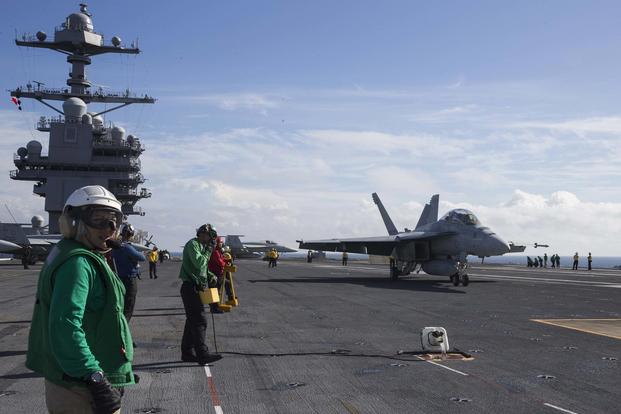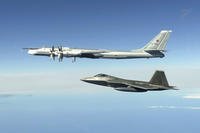President Donald Trump used one of his Thanksgiving Day phone calls to service members to raise questions again on the reliability of the new electromagnetic system for launching aircraft from carriers versus older steam catapults.
In a call to the aircraft carrier Ronald Reagan, which was on a port visit to Hong Kong, Trump grilled Capt. Pat Hannifin, the nuclear-powered ship's commanding officer, on electromagnetic aircraft launchers (EMALS).
The first-in-class Gerald Ford, the U.S.' newest carrier and considered the most expensive warship ever built at an estimated $13 billion, features the EMALS system. The Nimitz-class Reagan uses steam catapults.
Trump first asked Hannifin about the condition of his ship. Before he could finish the answer, the president interjected, "Tell me about the catapult," according to the White House transcript of the phone calls.
"On Gerald Ford, they don't use steam, which is the first one that I've ever heard of that doesn't use steam," said Trump, who has previously questioned why the Navy went with EMALS on the Ford. "I know they have some difficulties, which I'm not happy about. They spent a lot of money. I was just curious. The steam system is tried and true for many, many years, as long as we've had aircraft carriers."
He asked Hannifin, "How do you find steam versus what they're doing on the Gerald Ford, which is electronic and digital, if you can believe it?"
Hannifin appeared ready for the question. "Yes sir, all of our Nimitz supercarriers have been using steam for decades, and we find it pretty reliable. However, the electromagnetic catapults they're running there [on the Ford] offer some great benefits," he said. "Obviously, any new piece, you've got to work through the bugs, but they offer some benefits, not only to stress and strain on the aircraft to extend service life."
Trump put Hannifin on the spot again. "So when you do the new carriers as you do and we're thinking of doing, would you go steam or would you go with the electromagnetic? Steam is very reliable, and the electromagnetic, I mean, unfortunately, you have to be Albert Einstein to work it properly."
Hannifin deftly deflected the Einstein reference. "Yes sir, you have to be Albert Einstein to run the nuclear power plants we have here as well [aboard the Reagan], but we're doing that very well," he said. "Sir, Mr. President, I would go electromagnetic 'cats.' I think that's the way to go. We do pay a heavy cost to transit the steam around the ship."
Trump responded, "Good, OK, I like to hear that. I'm actually happy about that answer because at least they're doing what they're doing, but that's actually a very good answer."
In a Navy release, Electronics Technician 2nd Class Michael Syzmanski, from Fort Worth, Texas, said he didn't mind having the president ask about EMALS.
"The president asked good questions about future technology and is very understanding of our naval systems and technology," he said. "I was very impressed and really enjoyed the overall experience."
In their holiday phone calls to service members, presidents usually avoid politics and stick to congratulating them on the jobs they do and thanking them for their sacrifices in serving the nation, but Trump broke with the tradition several times in his Thanksgiving Day calls.
In his phone call to Air Force Brig. Gen. David Lyons, commander of the 455th Air Expeditionary Wing at Bagram Airfield in Afghanistan, he seized on Lyons' comment that U.S. troops in Afghanistan are preventing terrorists from "reaching our shores again."
Trump used that comment to draw comparisons to his deployment of about 5,800 active-duty troops to the southern border to help stop "caravans" of migrant asylum seekers from crossing.
He told Lyons, "Large numbers of people are forming at our border, and I don't even have to ask you, I know what you want to do. You want to make sure that you know who we're letting in. … And we're not letting in anybody essentially because we want to be very, very careful."
Trump called the migrants "dangerous people" and told Lyons, "You're right. You're doing it over there. We're doing it over here."
He also asked Coast Guard Lt. Nick Hartmann, aboard the cutter Aquidneck in Bahrain about trade policy, which he said was a "very big subject" for his presidency. "We've been taken advantage of for many, many years by bad trade deals," Trump said.
Hartmann replied, "Mr. President, from our perspective out on the water, sir, we're seeing that there is an abundance of trade happening in the region. … There are vessels moving through the Straits of Hormuz and across the Arabian Gulf on a daily basis carrying cargo to and fro. And we don't see any issues in terms of trade right now, sir."
-- Richard Sisk can be reached at Richard.Sisk@Military.com.












